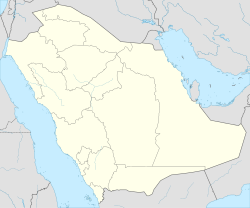Arar (city)
|
Arar عرعر |
|
|---|---|
| Location in the Kingdom of Saudi Arabia | |
| Coordinates: 30°59′N 41°1′E / 30.983°N 41.017°E | |
| Country |
|
| Province | Northern Borders |
| Established | 1951 |
| Elevation | 536 m (1,759 ft) |
| Population (2010) | |
| • Total | 166,512 |
| Area code(s) | +966- |
| Website | www |
Arar (Arabic: عرعر ʿArʿar [ˈʕarʕar]) is the capital of Northern Borders Province in Saudi Arabia. It has a population of 145,237 (2004 census).
Arar is located in northern Saudi Arabia near the Iraqi border. It is known for its fertile pasture lands which lends itself well to its principal occupation of sheep and camel herding. The population of the entire Northern Borders Province, including the cities of Rafha, Turayf and Alaoiqilah and suburban villages and their inhabitants, was 320,524 at the 2010 census. Arar serves as a significant supply stop for travelers on the Saudi Arabian highway 85.
The city of Arar was founded in 1951, after the construction of the Aramco oil pipeline (Tapline) was completed. It was initially an oil pumping station with a health center and worker housing. Workers at Arar were primarily from the regions of Al-Ahsa, Ha'il, Yanbu and Al Wajh.
Arar got its name from the original oil field that existed before the town, "Field RR", one of many in the country, where it was known by the locals as "R.R." which later became ʿArʿar. The name Arar means juniper in Arabic.
In 1968, the remains of an ancient city were unearthed 30 km from the city of 'Ar'ar. The site yielded numerous sculptures of fish, turtles and other aquatic animals.
A summit meeting between King Saud and King Hussein of Jordan took place in 'Ar'ar during the reigns of the two monarchs.
...
Wikipedia

